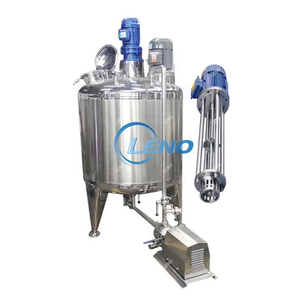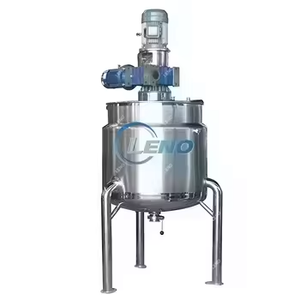
All categories
Featured selections
Trade Assurance
Buyer Central
Help Center
Get the app
Become a supplier

(3330 products available)



























A rotary agitator is a type of agitator that mixes or stirs a variety of materials within a container or tank. Rotary agitators are available in various forms, each suitable for different kinds of applications.
The rotary drum agitator is one of the most common types of rotary agitators. It consists of a rotating drum that mixes the contents of the container by rolling and tumbling. This agitator is usually used for low-viscosity materials and mixing or blending solid particles.
This agitator comprises a series of paddles or blades mounted on a central shaft. The rotary paddle agitator works by swirling the contents of the container while the paddles rotate. It is suitable for mixing and stirring various materials in different states of matter, including liquids, powders, and pastes. It is also used for mixing materials that are prone to stratification.
This agitator uses a belt to transfer power from the motor to rotate the shaft. It is simple to install and can be used in a wide range of applications. However, users must ensure that the belt is properly tensioned to prevent slipping during operation.
This rotary agitator uses a magnetic field to drive the rotation of the stirring element. It is usually used for applications requiring a seal between the chamber and the outside. In addition, the magnetic agitator is easy to clean and is suitable for use in sterile environments.
The direct-drive agitator is connected directly to the motor, enabling high-speed operation. This type of rotary agitator is suitable for applications that require high shear force and intense mixing, such as emulsification and dispersion. However, it may not be suitable for applications that require low-speed stirring and mixing.
This rotary agitator uses gears to transfer power from the motor to the shaft to realize rotation. The gear-driven agitator combines the advantages of high efficiency and reliability. It is suitable for applications requiring high torque output, such as large-capacity mixing and heavy-duty stirring.
Rotary agitators have many specifications that vary depending on the type and intended use. Below are some of the specifications of the rotary agitator.
Proper maintenance of the rotary agitator is essential to ensure it delivers optimal performance and longevity. Here are some general maintenance tips for the rotary agitator.
Rotary agitators are used in numerous industries and applications to mix or blend a wide range of materials. Here are some common usage scenarios for rotary agitators:
In pharmaceutical production, a rotary agitator mixer is often used to mix various powders, granules, or liquids, such as antibiotics, vitamins, and other pharmaceutical ingredients. This ensures a homogeneous mixture of components, contributing to the consistency and quality of the final product.
In chemical processing and manufacturing, rotary agitators are often used to mix chemicals, catalysts, or additives. Rotary agitators help ensure uniformity in chemical reactions, prevent stratification, and enhance the efficiency of the reaction process.
In the food and beverage industry, rotary agitators are widely used in the production of food, such as mixing ingredients, flavors, and food coloring. They ensure consistent quality and taste of the final product. Rotary agitators can also be used in the beverage industry to mix beverages, such as soft drinks and juices, to ensure uniformity and prevent settling of the ingredients.
In the paint and coating industry, rotary agitators are often used to mix paints, coatings, and pigments. Rotary agitators ensure consistent color and quality of the paint, prevent settling of pigments and additives, and maintain the desired viscosity.
In the water treatment industry, rotary agitators are used to mix chemicals, such as coagulants and flocculants. Rotary agitators help ensure effective water treatment by achieving uniform distribution of chemicals and promoting the aggregation of impurities for easier removal.
Rotary agitators are widely used in the construction materials industry, such as mixing concrete, mortar, and other building materials. Rotary agitators ensure uniformity of the mixture, improve workability, and enhance the strength of the final product.
In environmental engineering, rotary agitators are used in soil and water remediation projects. They help mix and disperse remediation agents for pollutants, ensuring effective treatment and cleanup.
In the metallurgical and mining industries, rotary agitators are used in ore dressing, smelting, and other processes. Rotary agitators help mix ore, additives, and fluxes, ensuring uniformity in the composition of materials and optimizing the extraction of valuable minerals.
When searching for rotary agitators for sale, it is important to consider the following factors so that the final purchase can meet the needs of the business.
When choosing a rotary agitator, it is first necessary to understand the needs of the application and determine the type of agitator required. For example, whether a paddle rotary agitator is required, which is more suitable for low-viscosity fluids, or a helical rotary agitator, which is better for mixing high-viscosity fluids. Selecting the appropriate type of rotary agitator based on the specific needs of the application can ensure that the final purchase will meet the needs of the business.
Quality and reliability are critical factors when choosing a rotary agitator. It is important to choose a reliable brand or supplier. This ensures that the rotary agitator purchased is of high quality and can provide excellent performance and long-term reliability. Additionally, if possible, it is recommended to check the supplier's product reviews and ratings to gain a better understanding of their reputation and reliability.
When purchasing a rotary agitator, technical support and after-sales service are also important. A good supplier should provide timely technical support and assistance to help solve problems that may arise during the use of the rotary agitator. In addition, reliable after-sales service, such as product warranties, maintenance support, and spare parts availability, can ensure that the rotary agitator continues to operate optimally over the long term. When choosing a supplier, it is important to consider their technical support and after-sales service capabilities.
Cost and budget are also important factors to consider when purchasing rotary agitators. It is important to establish a reasonable budget based on the needs of the application and to compare the prices and features of different rotary agitators. Doing so ensures that the final purchase is both cost-effective and meets business needs. Furthermore, when considering cost, it is important to consider the long-term operating and maintenance costs of the rotary agitator and not just the initial purchase price.
Recently, the trend of considering the impact of industrial processes on the environment is still growing. Therefore, it is important to choose a rotary agitator that is environmentally friendly. Some rotary agitators are designed to be energy-efficient or can be programmed to optimize energy consumption.
Q1: What is the difference between a rotary agitator and a shaker?
A1: The main difference between a rotary shaker agitator and a vortex mixer is that the former can hold more samples and is commonly used for larger volumes, whereas the latter is more suitable for smaller sample sizes.
Q2: What is the function of a rotary agitator?
A2: The rotary agitator mixes liquids, usually in a container, which can be anything from a beaker to a huge tank. The agitation can be anything from a gentle stirring to a violent mixing of the liquid.
Q3: What are the benefits of rotary agitators in industrial applications?
A3: The main benefits of a rotary agitator are that it can mix huge volumes of liquids in a short period. It can also be used to reduce sedimentation, ensure uniformity, and improve the efficiency of chemical reactions and other processes.